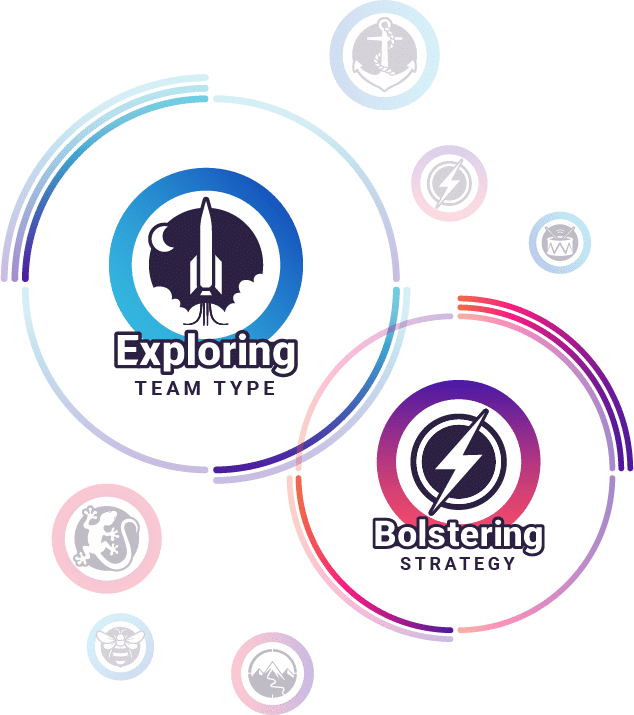
ANNUAL
CEO Benchmarking Report 2021
160 CEOs reveal their top concerns and priorities in a post-COVID remote world. Find out what’s caused executive teams to struggle in 2020—and what they’re doing to build dream teams that get along and get the job done in the year to come.
Understanding the future of leadership, teaming, remote work, and strategy
In September 2020, The Predictive Index surveyed 160 CEOs about their top priorities and concerns. Their answers provide a window into the minds of executive leaders during one of the most trying times in recent history.
COVID-19 has upended the nature of work. Employees are burnt out and disengaged after months of dealing with increased workloads, altered business strategies, and ambiguity. Parents are camped out at the kitchen table, trying to concentrate on work while their children are remote learning beside them. Essential workers are servicing their community while wearing masks and worrying about getting sick. And entire industries are preparing for a future where remote work isn’t a stopgap but a permanent reality.
For CEOs, these are unique challenges—and they beg important questions. How are CEOs feeling, months into the pandemic? How’s senior leadership holding up? Are teams prepared for the work ahead? The following study dug deep into these issues, revealing a common thread: Executive and critical teams are struggling to get along and deliver on strategy.
With 2020 nearly in the rearview mirror, CEOs are focusing on what’s ahead. The stakes are high, there’s work to do, and teams must accomplish more with less. To succeed, leaders will need to rely on their people more than ever and build dream teams that get the work done—no matter what the future holds.

After reading this report, you’ll understand what’s stressing CEOs—and why team cohesion is a top priority.
2021 is a whole new ballgame for CEOs and their teams. The findings in this report will open your eyes to the unique challenges executives are facing in a post-COVID world. You’ll discover what’s fracturing senior leadership and why team cohesion is critical to success. You’ll also learn how to build dream teams that work like magic—using talent optimization.
Team stress and the need for cohesion
“The coronavirus has put an unprecedented strain on executives and their people. Teams that overcome the stress and grow closer in spite of it will be all the stronger.”
– Allison Siminovsky, Ph.D. Director of People Science at The Predictive Index
Executives are leading all-new teams.
69% of companies restructured their teams during the pandemic.
While COVID-19 has radically altered life at home, it’s also forced companies to make tough decisions about their workforce and teams. The study began by asking CEOs to what degree the pandemic has forced their business to restructure. Sixty-nine percent of those surveyed said their company suffered layoffs or furloughs since March 2020. Of the organizations that restructured, 28% let go at least one-fourth of the company.
What percentage of your company’s employees have been laid off or furloughed since March 2020?

 KEY TAKEAWAY
KEY TAKEAWAY
It’s no surprise employee productivity is a major concern for CEOs. Layoffs bring feelings of anxiety and guilt for employees who remain. Also, restructuring means new teams are formed—and thus, new people problems to address.

Remote work is here to stay.
97% of CEOs are allowing some degree of remote work moving forward.
Teams aren’t just new—they’re virtual. And for most CEOs, it’s clear there’s no turning back. When asked what their plans are for remote work moving forward, 76% of CEOs said they’ll allow remote work on a full-time basis “for all or most employees.” An overwhelming 97% of companies will allow remote work in some form moving forward.
Moving forward, we plan on allowing remote work:
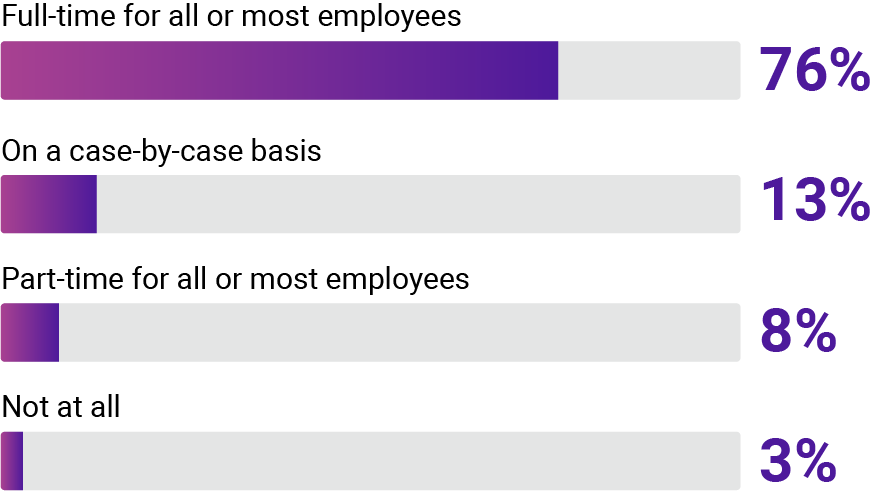
 KEY TAKEAWAY
KEY TAKEAWAY
Once considered a perk only progressive companies offered, remote work has become the new normal. Not only does remote work change how teams communicate and collaborate; it can decrease employees’ confidence in the strategy.
CEOs’ No. 1 challenge is helping their remote teams work well together.
51% of CEOs cited “working well remotely” as a top hurdle.
Companies may be committed to remote work, but that doesn’t mean the shift has been easy. The study asked CEOs to list their three biggest challenges in this new normal. More than half of the respondents selected Working well remotely. It was the most popular response by a wide margin.
The second-most popular response was Finding the right talent (25%). Compared to the 2019 CEO Benchmarking Report, that’s a decrease of 12%.
As CEO, which of the following are your biggest challenges?
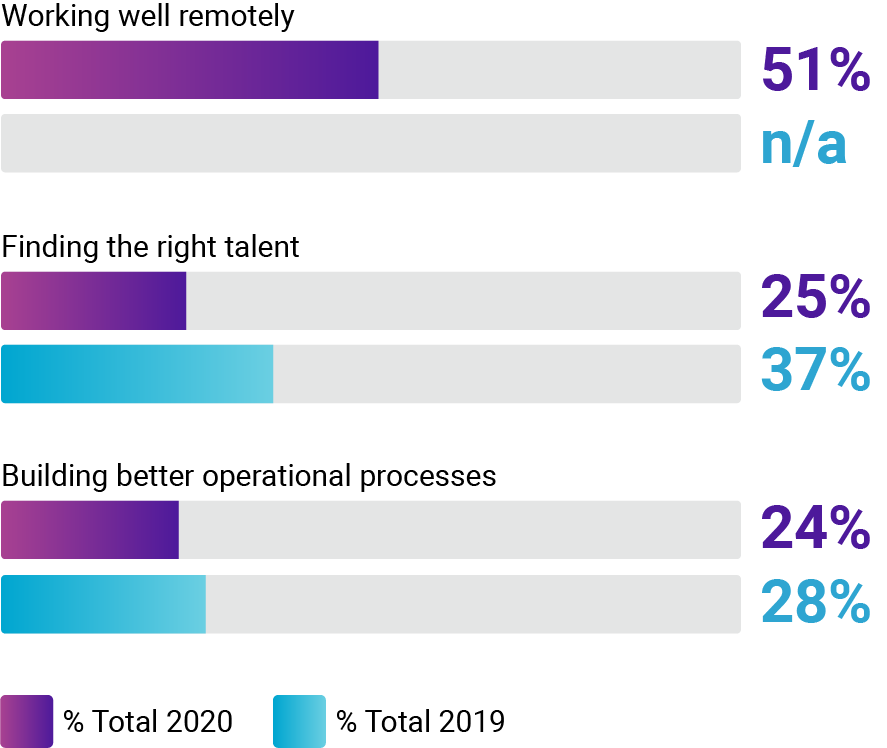
 KEY TAKEAWAY
KEY TAKEAWAY
Last year, finding the right talent was the No. 1 CEO challenge. But with COVID-19 and the economic downturn, CEOs have had to cut costs and reduce spending—and that means many companies have had to slow or freeze hiring.

CEOs are most concerned about employee productivity.
56% of CEOs say employee performance is of high concern.
The study continued by asking CEOs what’s keeping them up at night. In the 2019 CEO Benchmarking Report, the top answer among respondents was Employee performance and productivity. Thirty-six percent stated it was of high concern.
That sentiment skyrocketed in 2020—56% of CEOs now say employee performance is a top concern. This worry comes amid the brand-new challenge of COVID-19. Forty-eight percent of CEOs say they’ve lost sleep over how the virus is impacting their business. They’re also worried about Customer satisfaction, which saw an 8% increase from 2019.
Which of the following are of high concern to you?
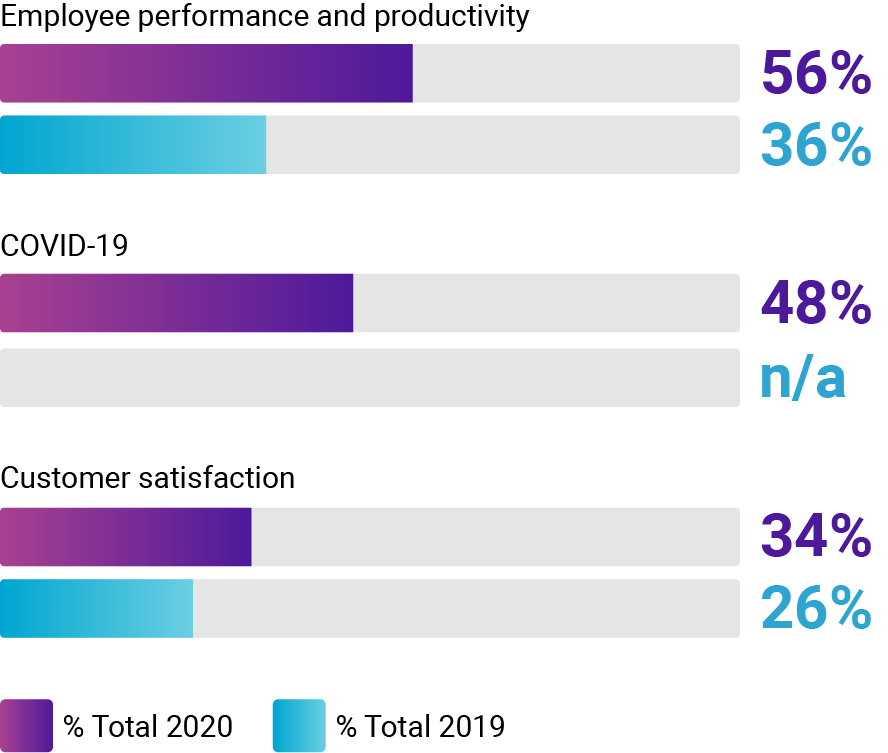
 KEY TAKEAWAY
KEY TAKEAWAY
As municipalities struggle to rein in the virus, CEOs are stressing over their employees and customers. COVID-19 has made it difficult to earn and keep new business. More than ever, CEOs are looking to retain the customers they have—and optimize their talent for 2021.

Senior leaders are struggling with team cohesion.
Since the pandemic began, fewer CEOs believe their teams have strong cohesion.
CEOs were presented with the following statement and asked to respond via a 5-point Likert scale (1=strongly disagree, 2=disagree, 3=neither agree nor disagree, 4=agree, 5= strongly agree): My team has strong cohesion. Researchers had them give two answers: one for how they were feeling at the time of the study (September 2020) and another for how they felt back in March 2020.
As of September, 78% of CEOs believed their executive team had strong cohesion. That’s a 10% decrease from March 2020. And the difference was even starker among CEOs who “strongly agreed” with the statement: Only 41% strongly agreed, down 17% from March.
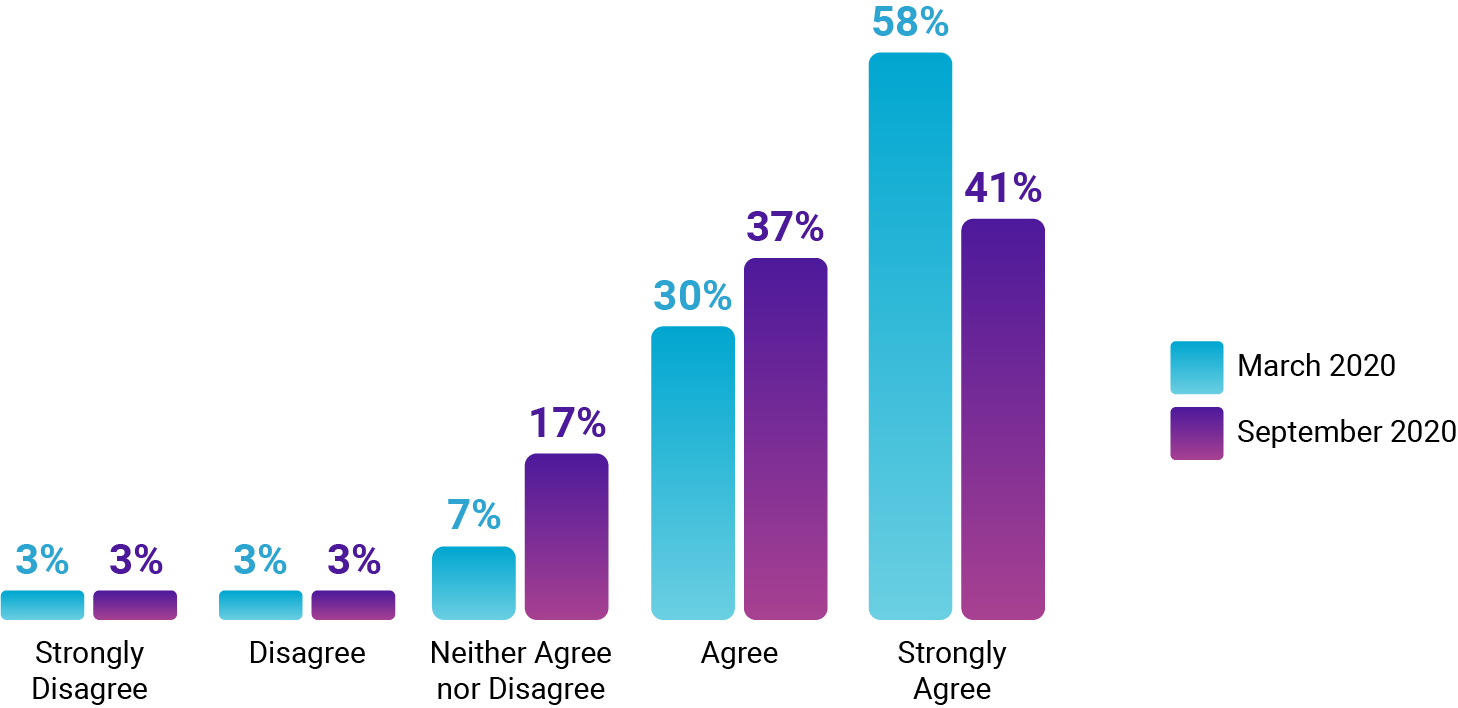
My team has strong cohesion.

Remote work is amplifying the lack of cohesion.
The closer organizations are to being fully remote, the more significant their cohesion issues.
Researchers also wanted to better understand how remote work has impacted the effectiveness of executive teams. First, researchers asked CEOs whether at least 90% of their employees were currently working remotely full-time. Then, they asked a series of questions related to team performance.
The findings stood out immediately: As shown in the table below, CEOs whose operations are almost entirely remote tend to experience greater team struggles than CEOs with less-distributed teams.
Do you agree with the following statement?
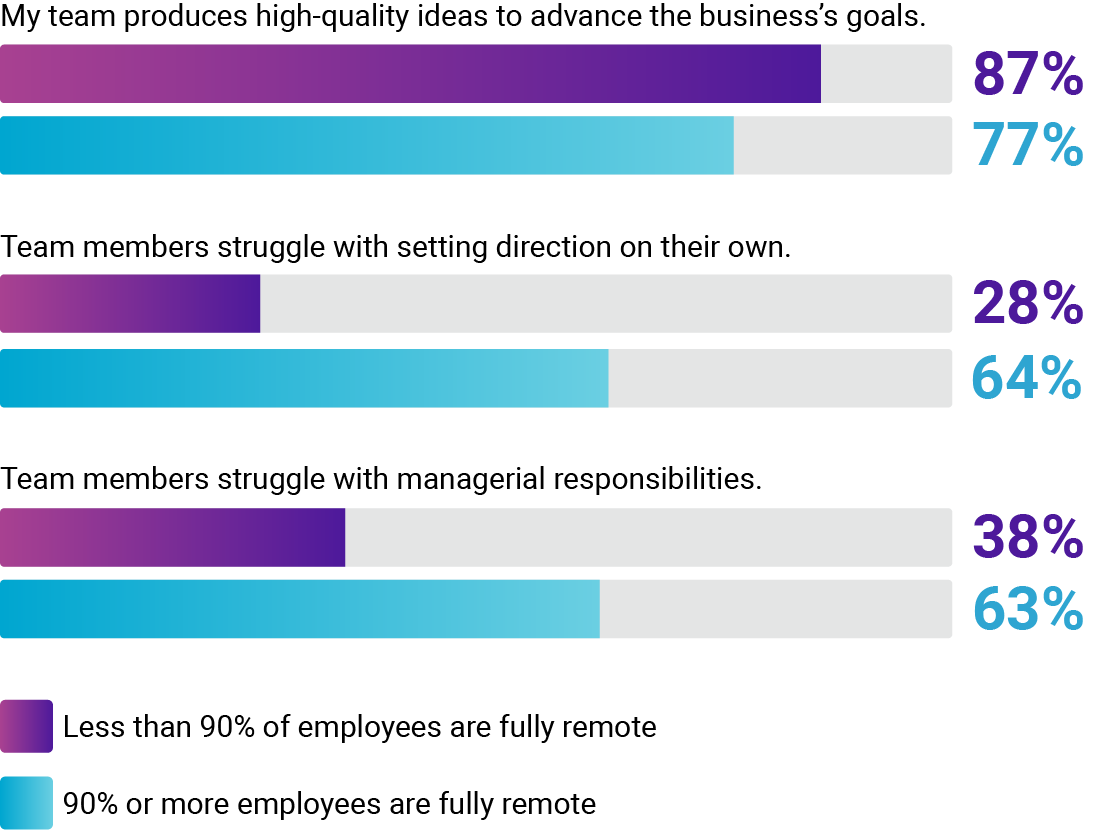
 KEY TAKEAWAY
KEY TAKEAWAY
Remote work came out of left-field for most CEOs. Even among leading tech companies, odds are these organizations had never gone completely remote. Following such a drastic shift under short notice, senior teams are still acclimating to the current world of perpetual Slack messaging and Zoom meetings.

CEOs lack confidence in their remote teams.
CEOs that lead remote teams are more likely to doubt the team’s ability to hit strategic goals.
As remote work disrupts the way teams work, it’s also eroding the confidence CEOs have in their teams to get that work done. Researchers asked CEOs how confident they are in their executive team’s ability to deliver on short- and long-term strategic goals. As shown below, CEOs that lead almost entirely remote teams are more likely to doubt their team’s ability than CEOs with less-distributed teams.
Do you agree with the following statement?
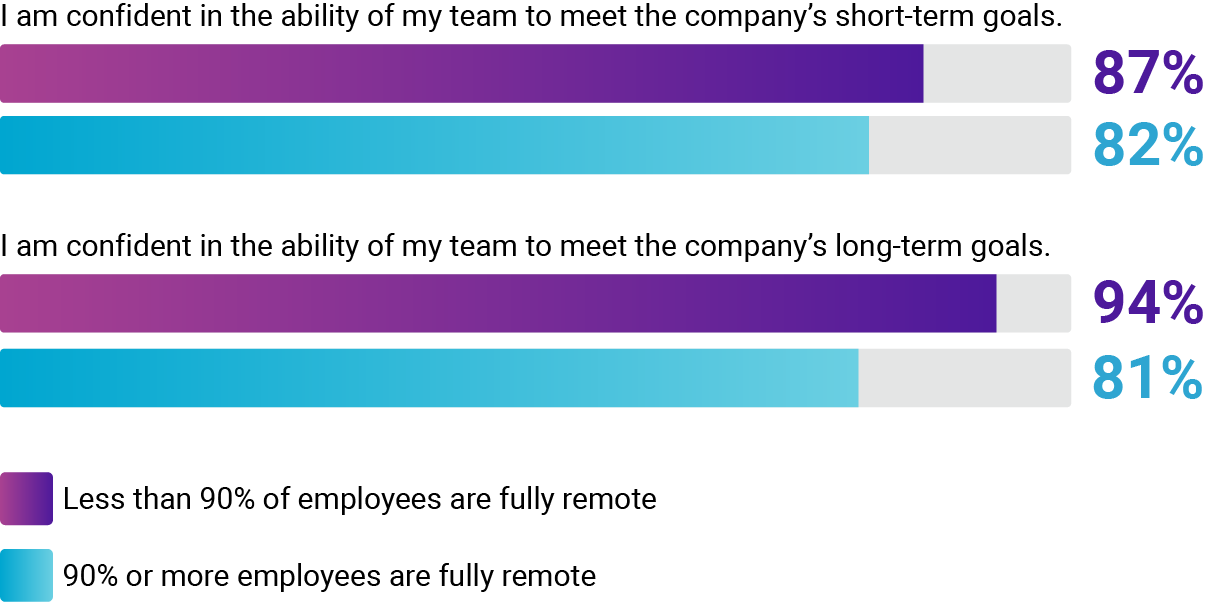

Team conflict stems from people problems.
36% of CEOs say conflict ties back to interpersonal struggles.
When cohesion is an issue, conflict typically isn’t far behind. Researchers asked CEOs that have experienced team conflict to describe what it most often relates to. While a portion of CEOs tied conflict to competing goals or contrasting views of how work gets done, the largest proportion—36%—said conflict ties back to interpersonal struggles.
When my team faces conflict, it is most often related to:
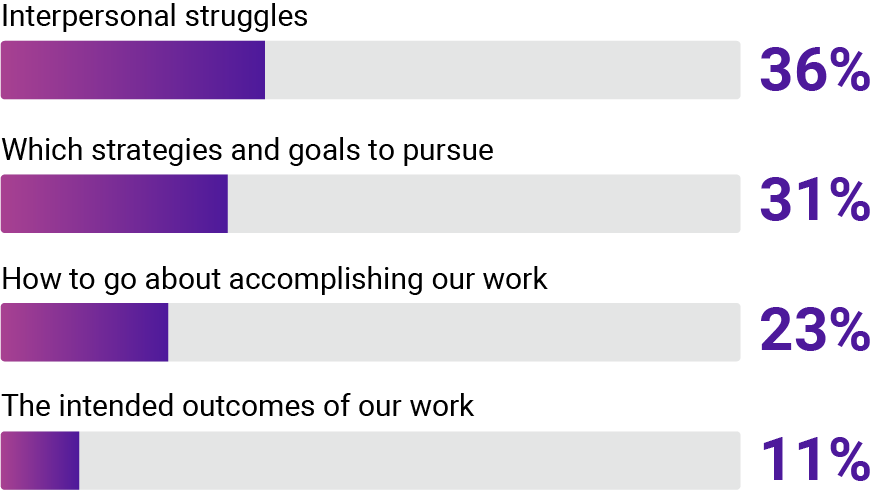
 KEY TAKEAWAY
KEY TAKEAWAY
When there’s infighting within teams, the most common causes aren’t business issues, but people ones. So when trying to solve these problems, it’s critical to take a people-first approach.

CEOs are spending precious time mediating people issues.
58% of CEOs admit they mediate interpersonal conflict at least monthly.
These team cohesion issues aren’t just prevalent; for many CEOs, they’re exhausting. Researchers provided CEOs the following statement and asked them to respond via a 5-point Likert scale (1=strongly disagree, 2=disagree, 3=neither agree nor disagree, 4=agree, 5= strongly agree): I mediate interpersonal conflict among team members at least once a month. Fifty-eight percent of respondents either “agreed” or “strongly agreed.”
I mediate interpersonal conflict among team members at least once a month.

 KEY TAKEAWAY
KEY TAKEAWAY
Critical team issues require critical attention—but CEOs are busy, especially amid a pandemic. If leadership teams are experiencing conflict and the CEO is forced to mediate, that’s time and energy that could be spent on other needs of the business.
Executive strategy and the work to be done
“COVID forced organizations to learn and adapt. For 2021, CEOs must build on those learnings—and ensure their teams are equipped for the work ahead.”
– Mike Zani, CEO at The Predictive Index
Most CEOs overhauled their business strategy in 2020.
96% of CEOs shifted strategic direction in some way since COVID-19.
CEOs have had to navigate entirely new business circumstances due to the pandemic. From supply chain disruptions to evolved buyer cycles, COVID-19 didn’t just alter the landscape; it redefined it. And CEOs adapted.
The study asked CEOs to answer the following: To what extent has the strategic direction of your company shifted since March 2020? A whopping 96% of respondents said they changed direction due to the pandemic, with 50% indicating their strategy shifted to a “great” extent.
To what extent has the strategic direction of your company shifted since March 2020?
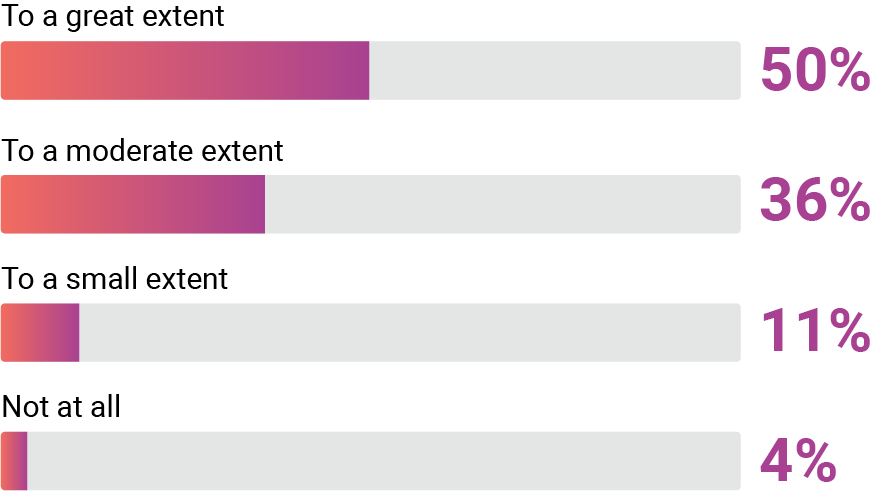

CEOs are laser-focused on strategy development.
53% of CEOs say strategy development is their No. 1 priority.
Companies have generally stabilized since the onset of the pandemic. But just because the crisis has eased, that doesn’t mean the hard work stops. When asked what is their No. 1 priority moving forward, 53% of CEOs said Strategy development, an increase of 14% from the 2019 CEO Benchmarking Report. Another 20% of CEOs said Operational execution was their top priority—a sign that teams are prioritizing the quality and efficiency of existing teams and offerings. Interestingly, only 17% of CEOs said Talent strategy—a 13% decline from 2019.
As a leader, you have many important areas of focus. Which of the following is your #1 priority?
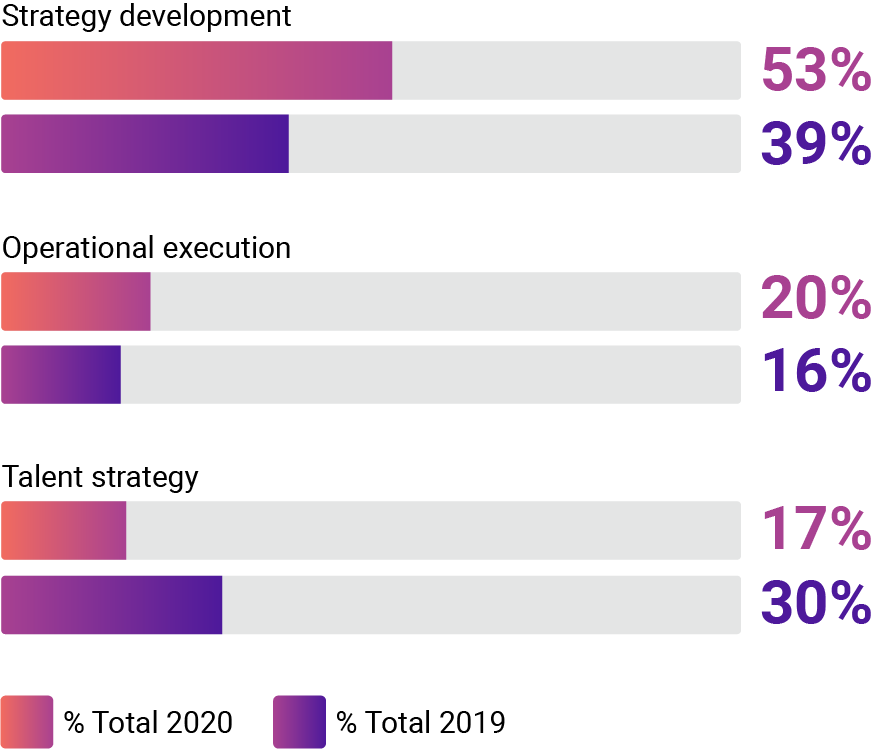
 KEY TAKEAWAY
KEY TAKEAWAY
As organizations look to bounce back from 2020 stronger, many CEOs have ambitious goals. While achieving them requires a strong business strategy, executives can’t afford to neglect talent strategy. Businesses don’t run themselves; people do. And that means building a talent strategy that prepares employees for the work ahead.
Employees are less clear on strategy.
Fewer CEOs believe their employees understand the mission and strategy now than before the pandemic.
As CEOs make critical decisions about the future of their business, the shift in strategy hasn’t been without bumps in the road.
Respondents were presented with the following statement and asked to respond via a 5-point Likert scale (1=strongly disagree, 2=disagree, 3=neither agree nor disagree, 4=agree, 5= strongly agree): Employees across the company clearly understand the company’s mission and strategy. Researchers asked CEOs to answer twice: once for how they’re feeling now (September 2020) and again for how they felt back in March 2020.
As of September, 83% of CEOs said their employees are clear on the strategy. That’s a 4% decline since March—and an indication there’s growing confusion among employees about the mission at hand.
Employees across the company clearly understand the company’s mission and strategy.
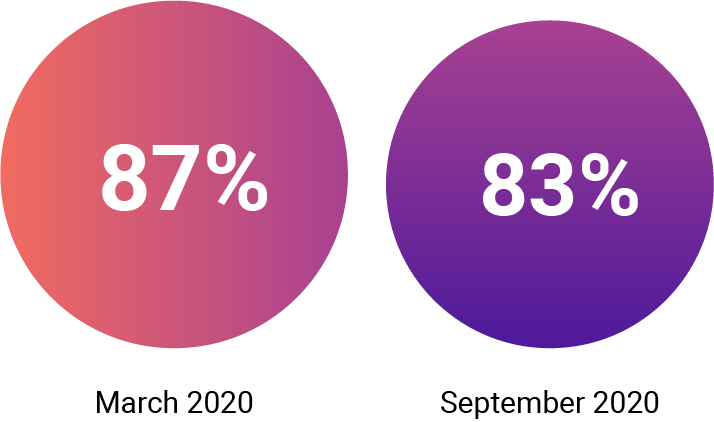
 KEY TAKEAWAY
KEY TAKEAWAY
When COVID set in, CEOs and their teams had to move quickly to adapt, stabilize, and survive. When senior leadership is making major decisions at lightning speed, it’s easy for middle managers to lose clarity—especially in a remote environment. As companies recover and set their sights on thriving in 2021, clear direction is more important than ever.

Lack of strategic clarity runs deep within the organization.
Less than 80% of CEOs believe in their employees’ ability to communicate the strategy to others.
Researchers had CEOs answer another statement, again asking them to respond via a 5-point Likert scale (1=strongly disagree, 2=disagree, 3=neither agree nor disagree, 4=agree, 5= strongly agree): Employees across the company are able to effectively communicate the company’s mission and strategy to others. Only 79% of CEOs agreed with the statement, down 4% from March.
Employees across the company are able to effectively communicate the company’s mission and strategy to others.
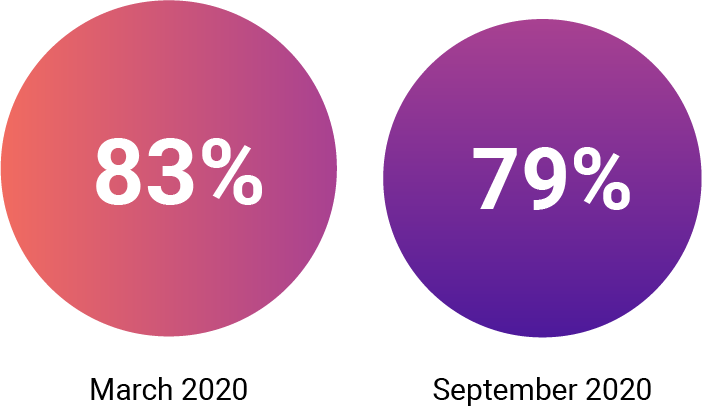
 KEY TAKEAWAY
KEY TAKEAWAY
Executing strategy can often feel like a game of telephone: If middle managers aren’t clear on the direction up top, that confusion will only amplify further down the org. Senior leaders must communicate clearly and regularly with the talent responsible for executing strategy. Otherwise, the work will never get done.
Building dream teams with talent optimization
“Senior leadership should feel confident it has the right teams to execute strategy. With talent optimization, the path to designing those dream teams is clearer than ever.”
– Daniel Muzquiz, President at The Predictive Index

Unlock the magic of dream teams.
It’s no secret that people are pivotal to business success. In the 2020 State of Talent Optimization Report, researchers uncovered the positive results businesses achieve when they align their business strategy with a matching talent strategy.
That’s talent optimization: a powerful discipline that helps leaders put people in the right places, at the right times, for the right business needs. It relies on objective people data, such as cognitive ability and behavioral fit. By leveraging these data points, leaders can build dream teams that are cohesive, trusting, and intentionally designed to tackle the work at hand.
Learn more about talent optimization, and the dream teams it helps build, below.
Senior leaders want to improve people relationships.
66%
of CEOs say their leadership teams promote a culture of long-term affiliation.
Most executive teams recognize the need for talent optimization, even if they don’t know it by name. Researchers asked CEOs to answer the following: Which of the following best describes the culture of your current executive team? Sixty-six percent of CEOs selected: Enhancing the quality of working relationships, robust development and mentorship opportunities, and long-term affiliation.
 KEY TAKEAWAY
KEY TAKEAWAY
Talent optimization focuses on a business’s most expensive and powerful asset—people. And CEOs recognize that power, too. Despite the interpersonal conflict executive teams face, the majority of CEOs are committed to the long-term mentorship and development of their people.

Most CEOs need outside help with talent optimization.
91%
said they needed outside help with both business and talent strategies in the past six months.
CEOs don’t just recognize the need to optimize their talent; they also need help doing so.
Researchers asked CEOs to what extent they’ve needed external help with their business and talent strategies in the past six months. The trends were clear on both sides of the strategic fence: Ninety-four percent of CEOs said they needed help with business strategy, and 91% with talent strategy.
While these alone are critical findings, they lead to something even more striking: Ninety-one percent of CEOs indicated they needed help with both business and talent strategies. Talent optimization hinges on aligning both sides of the equation—so the fact CEOs are struggling with both shows how valuable an outside perspective can be.

CEOs want help inspiring performance and leadership.
58% of CEOs say they could use consultant help to improve employee performance.
The study had CEOs elaborate on how they might leverage outside help moving forward. Researchers asked them the following: As of September 2020, in which areas could you benefit from a consultant to help with talent strategy? The most popular response was Employee performance (58%), followed by Leadership development (48%) and Succession planning (36%).
CEOs don’t just want to inspire employees for the here and now. They want to develop future leaders—ones that will continue to drive the organization forward. And, these executives need a consultant to help them do so.
As of September 2020, in which areas could you benefit from a consultant to help with talent strategy? Select all that apply.
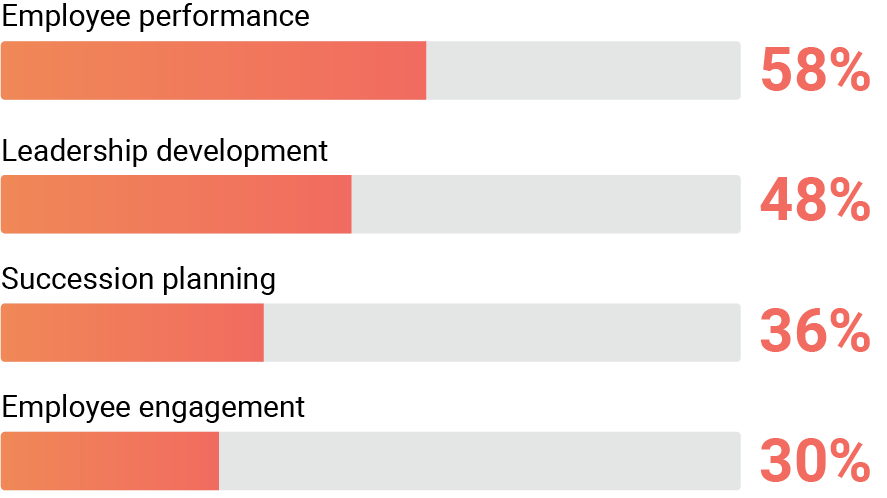
 KEY TAKEAWAY
KEY TAKEAWAY
Talent optimization is a comprehensive discipline. With CEOs’ time split between strategy development and daily operations, they can’t achieve talent optimization alone. Instead, CEOs should invest in a talent optimization consultant who’s trained to interpret people data—and build dream teams that get the work done.

Designing dream teams, made easy.
Between navigating the pandemic, the economy, and a remote future, CEOs have critical business problems to solve. But their people issues aren’t going away—and the need for cohesion can’t be overstated.
With the help of a PI Certified talent optimization consultant, CEOs can turn any team into a dream team. Each PI consultant is certified in The Predictive Index platform and is equipped with science-backed recommendations to help senior leaders and critical teams build cohesion and reduce conflict.
Through an initial 1:1 strategy session, a PI consultant helps CEOs uncover their unique Team Type. This designation helps CEOs better understand the behavioral makeup of their team. For example, one executive team may discover it’s a Cultivating Team. These teams strive for consensus, prioritize group decision-making, and put a premium on interpersonal relationships.
Through this revealing process, CEOs and their teams will discover their natural superpowers, as well as any caution areas. They’ll also learn how these strengths and weaknesses map back to the business strategy. Take the Cultivating Team from before: The team may value consensus, but if the strategy requires quick decision-making, consensus won’t always be possible.
By understanding how team behaviors impact the work to be done, leaders can gain renewed clarity and confidence about the road ahead—and rekindle the magic of a true dream team.

Conclusion: Dream teams get the work done—so you can focus on strategy.
COVID-19 has made it more difficult to earn and keep new business. More than ever, CEOs are looking to retain the customers they have while also getting the most out of the people they have.
To stay afloat, 69% of companies restructured their teams since March 2020. Many others were forced into remote work. Major changes like these pile stress on even the strongest of teams—especially when compounded by personal worries and challenges.
Despite the interpersonal disconnect and strain most teams are facing right now—whether remote or otherwise—the majority of CEOs are committed to making remote work a success. Ninety-seven percent plan to allow remote work beyond the pandemic. They understand that the future of work has changed forever, and they know they must adapt to remain competitive.
Yet good intentions aren’t enough to get stuck teams unstuck. To improve team collaboration, communication, and cohesion in a meaningful way, CEOs must take a new approach to talent strategy: one that requires understanding themselves, their teams, and their strategy—together.
Make remote work.
Bring back the excitement. Inspire your team to crush their goals. Feel the joy of working on a team that trusts each other. You’ve felt the magic of being on a dream team before, and you’re about to feel that magic again.
Study methodology
This report was developed with scientific rigor.
Good surveys begin with identifying the population of interest. Because we wanted to explore the practices of people who directly set and influence business and talent strategies, we partnered with Qualtrics, an organization that specializes in surveying executive audiences. The research sample was restricted to 160 chief executive officers, presidents, and chairpeople at U.S. companies with 25-1,000 employees.
We developed the survey questions according to best practices in survey research, ensuring they were clear, concise, and understandable by people with a variety of backgrounds. Questions had response formats designed to balance the richness of data to be collected with the ease of responding. The topics were selected based on a set of research questions identified by subject matter experts as being relevant to emerging trends in executive leadership and strategic planning since the onset of the COVID-19 crisis. Together, all of this encouraged participant engagement and high-quality responses while collecting in-depth information about team cohesion and performance.
